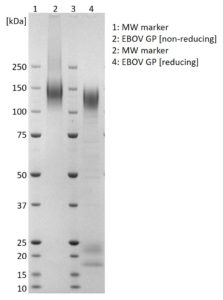SDS-PAGE: Coomassie-stained SDS-PAGE showing Ebola virus envelope glycoprotein (GP).
Ebola Virus Envelope Glycoprotein (GP) (Zaire, Boende-Lokolia)
Price range: $746.23 through $1,345.31 excl. VAT
Ebola Virus Envelope Glycoprotein (GP) (Zaire, Boende-Lokolia) is a recombinant protein produced in HEK293 cells with a C-term His-tag. Ebola GP (Zaire Boende-Lokolia) has been developed for use in immunoassay and vaccine development.
EBOLA VIRUS GLYCOPROTEIN (GP) (ZAIRE, BOENDE-LOKOLIA)
Ebola Virus Envelope Glycoprotein (GP) (Zaire, Boende-Lokolia) is a recombinant protein produced in HEK293 cells. Ebola GP (Zaire Boende-Lokolia) has been developed for use in immunoassay and vaccine development.
PRODUCT DETAILS – EBOLA VIRUS GLYCOPROTEIN (GP) (ZAIRE, BOENDE-LOKOLIA)
- Recombinant Ebola GP (Zaire Boende-Lokolia) (NCBI AIO11753, AA1-637) was expressed in HEK293 cells, and contains a C-terminal His-tag.
- Sequence strain is Ebola virus/H.sap-wt/COD/2014/Boende-Lokolia.
- Protein was purified from culture supernatant by a series of immobilised metal affinity, ion exchange and size exclusion chromatography.
- Presented in phosphate buffered saline (DPBS), pH7.4.
BACKGROUND
Ebola hemorrhagic fever (EHF) is a severe disease caused by several species of Ebolavirus (EBOV), in the family Filoviridae. Prior to 2007, four species of EBOV had been identified, with two (Zaire ebolavirus andSudan ebolavirus) having caused significant disease outbreaks in humans. The presence of a fifth EBOV virus species, Bundibugyo ebolavirus (BEBOV) was identified after an outbreak of EHF in the Bundibugyo District of western Uganda in 2007. Outbreaks of EHF are associated with person-to-person transmission after the virus is introduced into humans from a zoonotic reservoir. During outbreaks the virus is commonly transmitted through direct contact with infected persons or their bodily fluids. The onset of EHF is associated with nonspecific signs and symptoms, including fever, myalgias, headache, abdominal pain, nausea, vomiting, and diarrhoea. In the later stages of disease, overt haemorrhage has been reported in up to 50% of cases.
The Zaire subtype of the Ebola virus family is currently the most important in relation to outbreaks of disease in humans. This subtype has been responsible for the largest ever outbreak of EHF, which started in West Africa in 2014, and was finally declared over only in early 2016. The Kikwit-95 strain was isolated from an outbreak occurring in the city of Kikwit in Zaire in 1995. This outbreak has been especially well studied. There were 314 cases, with 244 fatalities, a mortality rate of greater than 75%. In 2014, 66 cases of Ebola virus disease, including 49 deaths were diagnosed, initially in Equateur province (Watsi Kengo, Lokolia, Boende, and Boende Muke) (WHO, 2017). In contrast to the virus sampled from outbreaks in West Africa, the sequences from COD (COD/2014/Boende-Lokolia, COD/2014/Lomela-Lokolia16, COD/2014/Lomela-Lokolia17, and COD/2014/Lomela-Lokolia19) were phylogenetically closer to the ZEBOVs isolated during the 1995-1996 outbreaks in equatorial Africa (Lam et al., 2015).
Ebola virus envelope glycoprotein is initially produced as a precursor known as pre-GP, which is cleaved by furin into two subunits, GP1 and GP2, which remain associated through a disulfide linkage between Cys53 of GP1 and Cys609 of GP2. This heterodimer assembles into a 450-kDa trimer at the surface of nascent virions. The virion-attached GP is critical in the EBOV life cycle, as it is solely responsible for attachment, fusion and entry of target cells. Moreover, GP is responsible for critical pathogenic differences among viral species.
The role of Ebola virus envelope glycoprotein (GP) in EBOV pathogenesis is unclear, but is examined in detail by Lee and Saphire (2009).


